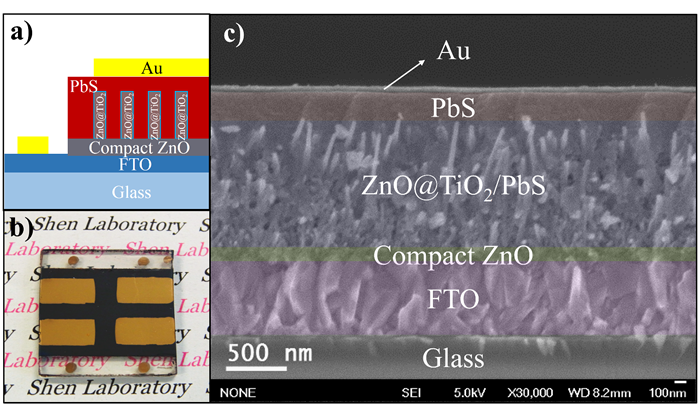September 2015 Issue
Research Highlights
Nanowire quantum dot solar cells: oxide layer boosts performance
Attempts to improve solar cells can seem a balancing act, as optimising one variable can compromise another. The introduction of nanowires to colloidal quantum-dot solar cells (CQDSCs) aroused interest as a means of improving a limitation in the charge-collection layer thickness. However the high nanowire surface area brings other inhibiting factors. Now Jin Chang, Qing Shen and colleagues demonstrate how a further modification using an oxide layer can reduce the nanowire surface area effects for better-performing solar cells.
Colloidal quantum dots offer a number of advantages for solar cells: they provide effective charge separation layers for producing a photocurrent; have tunable band gaps; and can be solution-processed at low temperatures. However the low diffusion length for charge carriers generated in colloidal quantum dots limits the maximum layer thickness - it must be no thicker than the distance the carriers can travel to reach the heterojunction before recombining. This limited thickness caps the energy absorption capacity.
Penetrating the quantum-dot layers with nanowire heterojunctions can allow greater thicknesses. But since recombination occurs at interfaces, the higher surface of nanowire heterojunctions undermines the advantage made.
Chang, Shen and colleagues at the University of Electro-Communications and CREST in Japan, Universitat Jaume I in Spain, Kyushu Institute of Technology and King Abdulaziz University in Saudi Arabia show that a titanium oxide layer can passivate the surface of the nanowires thereby reducing recombination. The oxide layer allows a 40% improvement in the energy conversion efficiency of the devices and they are stable in air for over 130 days.
"This work highlights the significance of metal oxide passivation in achieving high performance bulk heterojunction solar cells," conclude the authors. "The charge recombination mechanism uncovered in this work could shed light on the further improvement of PbS CQDSCs and/or other types of solar cells."
Reference
Jin Chang,*1,2 Yuki Kuga,a Iván Mora-Seró,3 Taro Toyoda,1,2 Yuhei Ogomi,4,2
Shuzi Hayase,4,2 Juan Bisquert3,5 and Qing Shen,*1,2 High reduction of interfacial charge recombination in colloidal quantum dot solar cells by metal oxide surface passivation, Nanoscale, 7, 5446 (2015).
- Faculty of Informatics and Engineering, The University of Electro-Communications,1-5-1 Chofugaoka, Chofu, Tokyo 182-8585, Japan.
- CREST, Japan Science and Technology Agency (JST), 4-1-8 Honcho, Kawaguchi, Saitama 332-0012, Japan
- Photovoltaic and Optoelectronic Devices Group, Department de Física, Universitat Jaume I, 12071 Castelló, Spain
- Faculty of Life Science and Systems Engineering, Kyushu Institute of Technology, 2-4 Hibikino, Wakamatsu-ku, Kitakyushu, Fukuoka 808-0196, Japan
- Department of Chemistry, Faculty of Science, King Abdulaziz University, Jeddah, Saudi Arabia
- *corresponding author e-mail:





